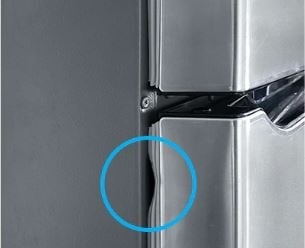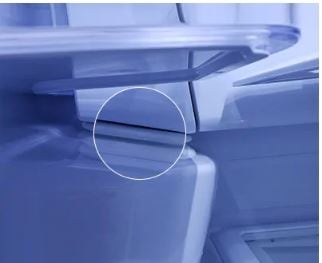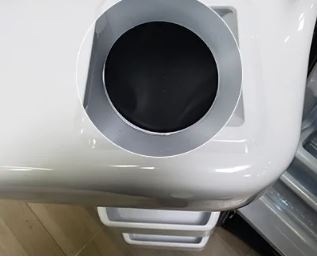How to prevent frost forms in the freezer or fridge?
Moisture forms in the fridge when warm air enters through a door being left open, warm or hot items stored inside, or compartments not sealing properly. When moisture freezes, it becomes frost. So let's take a look at where the frost is and what we can do to prevent it from happening in the future.
Potential Causes of Frost
If the door seal is not damaged, here are some potential causes for the frost and how you can prevent it in the future.
- The more you leave the door open, the more warm air gets into your freezer, causing frost. Try not to make frequently opening the door a habit.
- The average amount of time the door should be left open is under 1 minute. This will improve cooling performance, energy efficiency, and frost prevention.
- All the cold air rushes out every time the doors are opened, so too much empty space just makes it easier for larger amounts of warm air to rush in. You can reduce this effect by filling the space in your freezer; if you don't have a lot of food items to use, you can fill up several water bottles instead.
- Hot items are almost guaranteed to create frost, particularly in humid conditions. Let hot items cool to room temperature before putting them in the freezer.
It's also important to let hot items cool before putting them in the refrigerator compartment too, or it can cause cooling issues.
- Vents are where moisture gets sucked out before it can become frost. If the vents are blocked, the moisture can't leave, and eventually the cold air turns the moisture into frost.Keep at least two inches of space around those vents at all times.
Warning: Do Not use a hair dryer to speed defrosting. This will damage the refrigerator.
(A.) Frost in the freezer
- Light Frost - Use a damp cloth to remove the frost and then wipe the freezer dry with a second cloth.
- Medium Frost - Use a plastic scraper to gently remove the frost. Wipe the freezer clean with a damp cloth and then dry it with a second cloth.
- Heavy frost - If there is a heavy buildup of frost, or if it's too hard to clear by hand, you'll need to defrost the freezer.

- If the freezer door is not completely closing, warm air is getting inside and causing frost. To check if the door is closing, put a flashlight in the freezer, turn it on, and point it at the door. With the door closed, if you can see any light shining out, that is where the door isn't completely closing.
- Pay special attention to areas where frost is forming the most, as those are most likely to be the areas that aren't sealing correctly.
- Also, inspect the rubber gasket all around the door for dirt or damage. If the rubber seal is dirty, then clean it using a mild detergent and damp cloth.
If the source of the warm air has been verified to be caused by something that cannot be corrected (such as a damaged door seal),
please visit the Support Center to request service.
(B.) Frost on the ice bucket
- Light Frost - Use a damp cloth to remove the frost and then wipe the freezer dry with a second cloth.
- Medium Frost - Use a plastic scraper to gently remove the frost. Wipe the freezer clean with a damp cloth and then dry it with a second cloth.
- Heavy frost - If there is a heavy buildup of frost, or if it's too hard to clear by hand, you'll need to defrost the freezer.
- Open the right side door only, keeping the left side door closed. Look inside the refrigerator at the closed left side door.
- Check for a gap between the ice bucket and the ice chute, which is part of the door. The gasket should sit flush up against the ice bucket. If there is a gap, warm air from the refrigerator compartment will enter the ice maker compartment and cause frost. This can also cause your ice to be wet and/or slushy.

To correct this condition, level the refrigerator, and adjust the doors. A properly leveled refrigerator will have the front of the refrigerator resting on the leveling legs and with the front wheels not in contact with the floor.
This can also cause your ice to be wet and/or slushy.If the ice bucket is not sealing correctly, warm air could enter the ice bucket.Remove the ice bucket, and inspect the rubber seal around it to confirm it is clean and not damaged. When reinserting the ice bucket, make sure it closes completely.If the ice bucket is damaged, it will need to be replaced. For warranty service, visit our Support Center.
This can also cause your ice to be wet and/or slushy.
If the flap on the ice dispenser is not closing properly, it will allow warm air to enter the ice maker compartment, and cause frost to build up. The most common reason for the flap to not close completely is ice, frost, or other debris having built up around the flap.
To check the flap, open the left side door, and look at the black flap inside the ice chute. If the flap is in the correct position, it is flush against the housing and airtight. If the flap is not flush with the housing, check for ice (or any other debris) that may be keeping the flap open.

Frost is an issue that is usually fixed by preventing warm air from getting into the refrigerator. In most cases, service is not required. After performing the steps above, clear the frost away and see if it returns.If the frost returns, visit our Support Center to request service.
Thank you for your feedback!
Please answer all questions.

